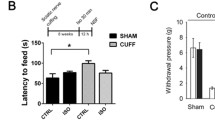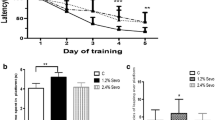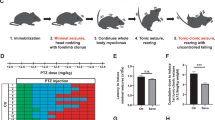Abstract
Ketamine is an ionic glutamic acid N-methyl-d-aspartate receptor (NMDAR) antagonist commonly used in clinical anesthesia, and its rapid and lasting antidepressant effect has stimulated great interest in psychology research. However, the molecular mechanisms underlying its antidepressant action are still undetermined. Sevoflurane exposure early in life might induce developmental neurotoxicity and mood disorders. In this study, we evaluated the effect of ketamine against sevoflurane-induced depressive-like behavior and the underlying molecular mechanisms. Here, we reported that A2AR protein expression was upregulated in rats with depression induced by sevoflurane inhalation, which was reversed by ketamine. Pharmacological experiments showed that A2AR agonists could reverse the antidepressant effect of ketamine, decrease extracellular signal-regulated kinase (ERK) phosphorylation, reduce synaptic plasticity, and induce depressive-like behavior. Our results suggest that ketamine mediates ERK1/2 phosphorylation by downregulating A2AR expression and that p-ERK1/2 increases the production of synaptic-associated proteins, enhancing synaptic plasticity in the hippocampus and thereby ameliorating the depressive-like behavior induced by sevoflurane inhalation in rats. This research provides a framework for reducing anesthesia-induced developmental neurotoxicity and developing new antidepressants.








Similar content being viewed by others
Data Availability
The datasets generated and/or analyzed during the current study are available from the corresponding author upon reasonable request.
References
Lenze EJ, Farber NB, Kharasch E, Schweiger J, Yingling M, Olney J, Newcomer JW (2016) Ninety-six hour ketamine infusion with co-administered clonidine for treatment-resistant depression: a pilot randomised controlled trial. World J Biol Psychiatry 17(3):230–238. https://doi.org/10.3109/15622975.2016.1142607
Dwyer JB, Landeros-Weisenberger A, Johnson JA, Londono Tobon A, Flores JM, Nasir M, Couloures K, Sanacora G, Bloch MH (2021) Efficacy of intravenous ketamine in adolescent treatment-resistant depression: a randomized midazolam-controlled trial. Am J Psychiatry 178(4):352–362. https://doi.org/10.1176/appi.ajp.2020.20010018
Berman RM, Cappiello A, Anand A, Oren DA, Heninger GR, Charney DS, Krystal JH (2000) Antidepressant effects of ketamine in depressed patients. Biol Psychiatry 47(4):351–354. https://doi.org/10.1016/s0006-3223(99)00230-9
Zanos P, Moaddel R, Morris PJ, Georgiou P, Fischell J, Elmer GI, Alkondon M, Yuan P, Pribut HJ, Singh NS, Dossou KS, Fang Y, Huang XP, Mayo CL, Wainer IW, Albuquerque EX, Thompson SM, Thomas CJ, Zarate CA Jr, Gould TD (2016) NMDAR inhibition-independent antidepressant actions of ketamine metabolites. Nature 533(7604):481–486. https://doi.org/10.1038/nature17998
Abdallah CG, Dutta A, Averill CL, McKie S, Akiki TJ, Averill LA, Deakin JFW (2018) Ketamine, but not the NMDAR antagonist Lanicemine, increases Prefrontal Global Connectivity in Depressed Patients. Chronic Stress (Thousand Oaks) 2. https://doi.org/10.1177/2470547018796102
Newport DJ, Carpenter LL, McDonald WM, Potash JB, Tohen M, Nemeroff CB (2015) Ketamine and other NMDA antagonists: early clinical trials and possible mechanisms in Depression. Am J Psychiatry 172(10):950–966. https://doi.org/10.1176/appi.ajp.2015.15040465
Kishimoto T, Chawla JM, Hagi K, Zarate CA, Kane JM, Bauer M, Correll CU (2016) Single-dose infusion ketamine and non-ketamine N-methyl-d-aspartate receptor antagonists for unipolar and bipolar depression: a meta-analysis of efficacy, safety and time trajectories. Psychol Med 46(7):1459–1472. https://doi.org/10.1017/s0033291716000064
Wei MD, Wang YH, Lu K, Lv BJ, Wang Y, Chen WY (2020) Ketamine reverses the impaired fear memory extinction and accompanied depressive-like behaviors in adolescent mice. Behav Brain Res 379:112342. https://doi.org/10.1016/j.bbr.2019.112342
Yang B, Ren Q, Ma M, Chen QX, Hashimoto K (2016) Antidepressant Effects of (+)-MK-801 and (-)-MK-801 in the social defeat stress model. Int J Neuropsychopharmacol 19(12). https://doi.org/10.1093/ijnp/pyw080
Pham TH, Gardier AM (2019) Fast-acting antidepressant activity of ketamine: highlights on brain serotonin, glutamate, and GABA neurotransmission in preclinical studies. Pharmacol Ther 199:58–90. https://doi.org/10.1016/j.pharmthera.2019.02.017
Liang L, Xie R, Lu R, Ma R, Wang X, Wang F, Liu B, Wu S, Wang Y, Zhang H (2020) Involvement of homodomain interacting protein kinase 2-c-Jun N-terminal kinase/c-Jun cascade in the long-term synaptic toxicity and cognition impairment induced by neonatal sevoflurane exposure. J Neurochem 154(4):372–388. https://doi.org/10.1111/jnc.14910
Xiao H, Liu B, Chen Y, Zhang J (2016) Learning, memory and synaptic plasticity in hippocampus in rats exposed to sevoflurane. Int J Dev Neurosci 48:38–49. https://doi.org/10.1016/j.ijdevneu.2015.11.001
Vutskits L, Xie Z (2016) Lasting impact of general anaesthesia on the brain: mechanisms and relevance. Nat Rev Neurosci 17(11):705–717. https://doi.org/10.1038/nrn.2016.128
Soriano SG, Vutskits L, Jevtovic-Todorovic V, Hemmings HC (2017) Thinking, fast and slow: highlights from the 2016 BJA seminar on anaesthetic neurotoxicity and neuroplasticity. Br J Anaesth 119(3):443–447. https://doi.org/10.1093/bja/aex238
Pavković Ž, Milanović D, Ruždijić S, Kanazir S, Pešić V (2018) The influence of propofol anesthesia exposure on nonaversive memory retrieval and expression of molecules involved in memory process in the dorsal hippocampus in peripubertal rats. Paediatr Anaesth 28(6):537–546. https://doi.org/10.1111/pan.13396
Liu H, Meng X, Li Y, Chen S, Ji Y, Song S, Ji F, Jin X (2022) Neonatal exposure to sevoflurane impairs preference for social novelty in C57BL/6 female mice at early-adulthood. Biochem Biophys Res Commun 593:129–136. https://doi.org/10.1016/j.bbrc.2022.01.022
Jin X, Ji L, Chen Q, Sheng R, Ji F, Yang J (2020) Anesthesia plus surgery in neonatal period impairs preference for social novelty in mice at the juvenile age. Biochem Biophys Res Commun 530(3):603–608. https://doi.org/10.1016/j.bbrc.2020.07.108
Raper J, Alvarado MC, Murphy KL, Baxter MG (2015) Multiple anesthetic exposure in infant monkeys alters emotional reactivity to an Acute Stressor. Anesthesiology 123(5):1084–1092. https://doi.org/10.1097/aln.0000000000000851
Chen Q, Chu W, Sheng R, Song S, Yang J, Ji F, Jin X (2021) Maternal anesthesia with sevoflurane during the mid-gestation induces social interaction deficits in offspring C57BL/6 mice. Biochem Biophys Res Commun 553:65–71. https://doi.org/10.1016/j.bbrc.2021.03.063
Oliveros A, Cho CH, Cui A, Choi S, Lindberg D, Hinton D, Jang MH, Choi DS (2017) Adenosine A(2A) receptor and ERK-driven impulsivity potentiates hippocampal neuroblast proliferation. Transl Psychiatry 7(4):e1095. https://doi.org/10.1038/tp.2017.64
Kaster MP, Machado DG, Santos AR, Rodrigues AL (2012) Involvement of NMDA receptors in the antidepressant-like action of adenosine. Pharmacol Rep 64(3):706–713. https://doi.org/10.1016/s1734-1140(12)70865-4
El Yacoubi M, Ledent C, Parmentier M, Costentin J, Vaugeois JM (2000) The anxiogenic-like effect of caffeine in two experimental procedures measuring anxiety in the mouse is not shared by selective A(2A) adenosine receptor antagonists. Psychopharmacology 148(2):153–163. https://doi.org/10.1007/s002130050037
Jain N, Kemp N, Adeyemo O, Buchanan P, Stone TW (1995) Anxiolytic activity of adenosine receptor activation in mice. Br J Pharmacol 116(3):2127–2133. https://doi.org/10.1111/j.1476-5381.1995.tb16421.x
Al-Attraqchi OHA, Attimarad M, Venugopala KN, Nair A, Al-Attraqchi NHA (2019) Adenosine A2A receptor as a potential drug target - current status and future perspectives. Curr Pharm Des 25(25):2716–2740. https://doi.org/10.2174/1381612825666190716113444
Yamada K, Kobayashi M, Shiozaki S, Ohta T, Mori A, Jenner P, Kanda T (2014) Antidepressant activity of the adenosine A2A receptor antagonist, istradefylline (KW-6002) on learned helplessness in rats. Psychopharmacology 231(14):2839–2849. https://doi.org/10.1007/s00213-014-3454-0
Yamada K, Kobayashi M, Mori A, Jenner P, Kanda T (2013) Antidepressant-like activity of the adenosine A(2A) receptor antagonist, istradefylline (KW-6002), in the forced swim test and the tail suspension test in rodents. Pharmacol Biochem Behav 114–115:23–30. https://doi.org/10.1016/j.pbb.2013.10.022
El Yacoubi M, Ledent C, Parmentier M, Bertorelli R, Ongini E, Costentin J, Vaugeois JM (2001) Adenosine A2A receptor antagonists are potential antidepressants: evidence based on pharmacology and A2A receptor knockout mice. Br J Pharmacol 134(1):68–77. https://doi.org/10.1038/sj.bjp.0704240
Wang JQ, Mao L (2019) The ERK Pathway: Molecular Mechanisms and Treatment of Depression. Mol Neurobiol 56(9):6197–6205. https://doi.org/10.1007/s12035-019-1524-3
Wu Z, Li X, Zhang Y, Tong D, Wang L, Zhao P (2018) Effects of Sevoflurane exposure during mid-pregnancy on learning and memory in offspring rats: Beneficial Effects of maternal Exercise. Front Cell Neurosci 12:122. https://doi.org/10.3389/fncel.2018.00122
Oh DR, Yoo JS, Kim Y, Kang H, Lee H, Lm SJ, Choi EJ, Jung MA, Bae D, Oh KN, Hong JA, Jo A, Shin J, Kim J, Kim YR, Cho SS, Lee BJ, Choi CY (2018) Vaccinium bracteatum Leaf Extract reverses chronic Restraint Stress-Induced Depression-Like Behavior in mice: regulation of hypothalamic-pituitary-adrenal Axis, serotonin turnover Systems, and ERK/Akt phosphorylation. Front Pharmacol 9:604. https://doi.org/10.3389/fphar.2018.00604
Lee CW, Chen YJ, Wu HF, Chung YJ, Lee YC, Li CT, Lin HC (2019) Ketamine ameliorates severe traumatic event-induced antidepressant-resistant depression in a rat model through ERK activation. Prog Neuropsychopharmacol Biol Psychiatry 93:102–113. https://doi.org/10.1016/j.pnpbp.2019.03.015
Gorain B, Choudhury H, Yee GS, Bhattamisra SK (2019) Adenosine receptors as novel targets for the treatment of various cancers. Curr Pharm Des 25(26):2828–2841. https://doi.org/10.2174/1381612825666190716102037
Chang D, Zhao J, Zhang X, Lian H, Du X, Yuan R, Wen Y, Gao L (2019) Effect of ketamine combined with DHA on lipopolysaccharide-induced depression-like behavior in rats. Int Immunopharmacol 75:105788. https://doi.org/10.1016/j.intimp.2019.105788
Wu Q, Chen J, Yue J, Ying X, Zhou Y, Chen X, Tu W, Lou X, Yang G, Zhou K, Jiang S (2021) Electroacupuncture improves neuronal plasticity through the A2AR/cAMP/PKA signaling pathway in SNL rats. Neurochem Int 145:104983. https://doi.org/10.1016/j.neuint.2021.104983
Al-Griw MA, Alghazeer RO, Awayn N, Shamlan G, Eskandrani AA, Alnajeebi AM, Babteen NA, Alansari WS (2021) Selective adenosine A(2A) receptor inhibitor SCH58261 reduces oligodendrocyte loss upon brain injury in young rats. Saudi J Biol Sci 28(1):310–316. https://doi.org/10.1016/j.sjbs.2020.09.063
Prut L, Belzung C (2003) The open field as a paradigm to measure the effects of drugs on anxiety-like behaviors: a review. Eur J Pharmacol 463(1–3):3–33. https://doi.org/10.1016/s0014-2999(03)01272-x
Gao QS, Zhang YH, Xue H, Wu ZY, Li C, Zhao P (2021) Brief inhalation of sevoflurane can reduce glial scar formation after hypoxic-ischemic brain injury in neonatal rats. Neural Regen Res 16(6):1052–1061. https://doi.org/10.4103/1673-5374.300456
Kraeuter AK, Guest PC, Sarnyai Z (2019) The forced swim test for Depression-Like Behavior in rodents. Methods Mol Biol 1916:75–80. https://doi.org/10.1007/978-1-4939-8994-2_5
Armario A (2021) The forced swim test: historical, conceptual and methodological considerations and its relationship with individual behavioral traits. Neurosci Biobehav Rev 128:74–86. https://doi.org/10.1016/j.neubiorev.2021.06.014
Jiang P, Guo Y, Dang R, Yang M, Liao D, Li H, Sun Z, Feng Q, Xu P (2017) Salvianolic acid B protects against lipopolysaccharide-induced behavioral deficits and neuroinflammatory response: involvement of autophagy and NLRP3 inflammasome. J Neuroinflamm 14(1):239. https://doi.org/10.1186/s12974-017-1013-4
Song AQ, Gao B, Fan JJ, Zhu YJ, Zhou J, Wang YL, Xu LZ, Wu WN (2020) NLRP1 inflammasome contributes to chronic stress-induced depressive-like behaviors in mice. J Neuroinflamm 17(1):178. https://doi.org/10.1186/s12974-020-01848-8
Satomoto M, Satoh Y, Terui K, Miyao H, Takishima K, Ito M, Imaki J (2009) Neonatal exposure to sevoflurane induces abnormal social behaviors and deficits in fear conditioning in mice. Anesthesiology 110(3):628–637. https://doi.org/10.1097/ALN.0b013e3181974fa2
Chung W, Park S, Hong J, Park S, Lee S, Heo J, Kim D, Ko Y (2015) Sevoflurane exposure during the neonatal period induces long-term memory impairment but not autism-like behaviors. Paediatr Anaesth 25(10):1033–1045. https://doi.org/10.1111/pan.12694
Tao G, Zhang J, Zhang L, Dong Y, Yu B, Crosby G, Culley DJ, Zhang Y, Xie Z (2014) Sevoflurane induces tau phosphorylation and glycogen synthase kinase 3β activation in young mice. Anesthesiology 121(3):510–527. https://doi.org/10.1097/aln.0000000000000278
Ju LS, Jia M, Sun J, Sun XR, Zhang H, Ji MH, Yang JJ, Wang ZY (2016) Hypermethylation of hippocampal synaptic plasticity-related genes is involved in neonatal sevoflurane Exposure-Induced cognitive impairments in rats. Neurotox Res 29(2):243–255. https://doi.org/10.1007/s12640-015-9585-1
Kong F, Zhang Y, Wang T, Zhong L, Feng C, Wu Y (2023) Repeated sevoflurane exposures inhibit neurogenesis by inducing the upregulation of glutamate transporter 1 in astrocytes. Eur J Neurosci 57(2):217–232. https://doi.org/10.1111/ejn.15874
Fan XY, Shi G, Zhao P (2021) Neonatal sevoflurane exposure impairs learning and memory by the hypermethylation of hippocampal synaptic genes. Mol Neurobiol 58(3):895–904. https://doi.org/10.1007/s12035-020-02161-4
Zhao X, Shi D, Du Y, Hu C, Li Y, Liu J, Pan C (2022) Repeated neonatal exposure to Sevoflurane induces age-dependent impairments in cognition and synaptic plasticity in mice. Dev Neurosci 44(3):153–161. https://doi.org/10.1159/000523730
Wu Y, Yang Z, Su S, Xu X, Li Y, Li X, Gao Y, Sun D, Wan S, Pen M, Jin W, Ke C (2022) Differential epitranscriptome and proteome modulation in the brain of neonatal mice exposed to isoflurane or sevoflurane. Cell Biol Toxicol. https://doi.org/10.1007/s10565-022-09701-9
Singh JB, Fedgchin M, Daly EJ, De Boer P, Cooper K, Lim P, Pinter C, Murrough JW, Sanacora G, Shelton RC, Kurian B, Winokur A, Fava M, Manji H, Drevets WC, Van Nueten L (2016) A Double-Blind, randomized, Placebo-Controlled, dose-frequency study of intravenous ketamine in patients with treatment-resistant depression. Am J Psychiatry 173(8):816–826. https://doi.org/10.1176/appi.ajp.2016.16010037
Phillips JL, Norris S, Talbot J, Birmingham M, Hatchard T, Ortiz A, Owoeye O, Batten LA, Blier P (2019) Single, repeated, and maintenance ketamine infusions for treatment-resistant depression: a Randomized Controlled Trial. Am J Psychiatry 176(5):401–409. https://doi.org/10.1176/appi.ajp.2018.18070834
Feder A, Costi S, Rutter SB, Collins AB, Govindarajulu U, Jha MK, Horn SR, Kautz M, Corniquel M, Collins KA, Bevilacqua L, Glasgow AM, Brallier J, Pietrzak RH, Murrough JW, Charney DS (2021) A randomized controlled trial of repeated ketamine administration for chronic posttraumatic stress disorder. Am J Psychiatry 178(2):193–202. https://doi.org/10.1176/appi.ajp.2020.20050596
Zhang F, Luo J, Zhu X (2018) Ketamine ameliorates depressive-like behaviors by tPA-mediated conversion of proBDNF to mBDNF in the hippocampus of stressed rats. Psychiatry Res 269:646–651. https://doi.org/10.1016/j.psychres.2018.08.075
Cui Y, Hu S, Hu H (2019) Lateral Habenular Burst Firing as a target of the Rapid Antidepressant Effects of ketamine. Trends Neurosci 42(3):179–191. https://doi.org/10.1016/j.tins.2018.12.002
Kim JW, Monteggia LM (2020) Increasing doses of ketamine curtail antidepressant responses and suppress associated synaptic signaling pathways. Behav Brain Res 380:112378. https://doi.org/10.1016/j.bbr.2019.112378
Simonini A, Brogi E, Cascella M, Vittori A (2022) Advantages of ketamine in pediatric anesthesia. Open Med (Warsaw Poland) 17(1):1134–1147. https://doi.org/10.1515/med-2022-0509
Dwivedi P, Patel TK, Bajpai V, Singh Y, Tripathi A, Kishore S (2022) Efficacy and safety of intranasal ketamine compared with intranasal dexmedetomidine as a premedication before general anesthesia in pediatric patients: a systematic review and meta-analysis of randomized controlled trials. Can J anaesthesia = Journal canadien d’anesthesie 69(11):1405–1418. https://doi.org/10.1007/s12630-022-02305-1
Nelson ST, Hsiao L, Turgeon SM (2019) Sex and housing conditions modify the effects of adolescent caffeine exposure on anxiety-like and depressive-like behavior in the rat. Behav Pharmacol 30(7):539–546. https://doi.org/10.1097/fbp.0000000000000489
Mitra S, Santana Miranda V, McMillan C, Dykes D, Mucha M, Marth TE, Poe B, Basu DG, Bult-Ito A (2020) Trait specific modulatory effects of caffeine exposure on compulsive-like behaviors in a spontaneous mouse model of obsessive-compulsive disorder. Behav Pharmacol 31(7):622–632. https://doi.org/10.1097/fbp.0000000000000570
Szopa A, Bogatko K, Serefko A, Wyska E, Wośko S, Świąder K, Doboszewska U, Wlaź A, Wróbel A, Wlaź P, Dudka J, Poleszak E (2019) Agomelatine and tianeptine antidepressant activity in mice behavioral despair tests is enhanced by DMPX, a selective adenosine A(2A) receptor antagonist, but not DPCPX, a selective adenosine A(1) receptor antagonist. Pharmacol Rep 71(4):676–681. https://doi.org/10.1016/j.pharep.2019.03.007
Vaz SH, Lérias SR, Parreira S, Diógenes MJ, Sebastião AM (2015) Adenosine A2A receptor activation is determinant for BDNF actions upon GABA and glutamate release from rat hippocampal synaptosomes. Purinergic Signal 11(4):607–612. https://doi.org/10.1007/s11302-015-9476-1
Li XC, Hong FF, Tu YJ, Li YA, Ma CY, Yu CY, Fang L, Chen JY, Li ZL, Bao SJ, Zhang ZL, Ying HY, Gyabaah AT, Hu SY, Shao GH, Cai XH (2022) Blockade of adenosine A(2A) receptor alleviates cognitive dysfunction after chronic exposure to intermittent hypoxia in mice. Exp Neurol 350:113929. https://doi.org/10.1016/j.expneurol.2021.113929
Ribeiro FF, Ferreira F, Rodrigues RS, Soares R, Pedro DM, Duarte-Samartinho M, Aroeira RI, Ferreiro E, Valero J, Solá S, Mira H, Sebastião AM, Xapelli S (2021) Regulation of hippocampal postnatal and adult neurogenesis by adenosine A(2A) receptor: Interaction with brain-derived neurotrophic factor. Stem Cells 39(10):1362–1381. https://doi.org/10.1002/stem.3421
Carvalho K, Faivre E, Pietrowski MJ, Marques X, Gomez-Murcia V, Deleau A, Huin V, Hansen JN, Kozlov S, Danis C, Temido-Ferreira M, Coelho JE, Mériaux C, Eddarkaoui S, Gras SL, Dumoulin M, Cellai L, Landrieu I, Chern Y, Hamdane M, Buée L, Boutillier AL, Levi S, Halle A, Lopes LV, Blum D (2019) Exacerbation of C1q dysregulation, synaptic loss and memory deficits in tau pathology linked to neuronal adenosine A2A receptor. Brain 142(11):3636–3654. https://doi.org/10.1093/brain/awz288
Lin S, Li Q, Jiang S, Xu Z, Jiang Y, Liu L, Jiang J, Tong Y, Wang P (2021) Crocetin ameliorates chronic restraint stress-induced depression-like behaviors in mice by regulating MEK/ERK pathways and gut microbiota. J Ethnopharmacol 268:113608. https://doi.org/10.1016/j.jep.2020.113608
Zhong X, Li G, Qiu F, Huang Z (2018) Paeoniflorin ameliorates chronic Stress-Induced Depression-Like Behaviors and neuronal damages in rats via activation of the ERK-CREB pathway. Front Psychiatry 9:772. https://doi.org/10.3389/fpsyt.2018.00772
Sierra-Fonseca JA, Parise LF, Flores-Ramirez FJ, Robles EH, Garcia-Carachure I, Iñiguez SD (2019) Dorsal Hippocampus ERK2 Signaling mediates anxiolytic-related behavior in male rats. Chronic Stress (Thousand Oaks) 3. https://doi.org/10.1177/2470547019897030
Lu J, Zhou H, Meng D, Zhang J, Pan K, Wan B, Miao Z (2020) Tanshinone IIA improves Depression-like Behavior in mice by activating the ERK-CREB-BDNF signaling pathway. Neuroscience 430:1–11. https://doi.org/10.1016/j.neuroscience.2020.01.026
Humo M, Ayazgök B, Becker LJ, Waltisperger E, Rantamäki T, Yalcin I (2020) Ketamine induces rapid and sustained antidepressant-like effects in chronic pain induced depression: role of MAPK signaling pathway. Prog Neuropsychopharmacol Biol Psychiatry 100:109898. https://doi.org/10.1016/j.pnpbp.2020.109898
Sowa J, Kusek M, Bobula B, Hess G, Tokarski K (2019) Ketamine Administration Reverses Corticosterone-Induced Alterations in Excitatory and Inhibitory Transmission in the Rat Dorsal Raphe Nucleus. Neural Plast 2019:3219490. doi:https://doi.org/10.1155/2019/3219490
Yang Y, Song Y, Zhang X, Zhao W, Ma T, Liu Y, Ma P, Zhao Y, Zhang H (2020) Ketamine relieves depression-like behaviors induced by chronic postsurgical pain in rats through anti-inflammatory, anti-oxidant effects and regulating BDNF expression. Psychopharmacology 237(6):1657–1669. https://doi.org/10.1007/s00213-020-05490-3
Atef RM, Agha AM, Abdel-Rhaman A-RA, Nassar NN (2018) The Ying and Yang of Adenosine A1 and A2A receptors on ERK1/2 activation in a rat model of Global Cerebral Ischemia Reperfusion Injury. Mol Neurobiol 55(2):1284–1298. https://doi.org/10.1007/s12035-017-0401-1
Acknowledgements
None.
Funding
This work was supported by the National Natural Science Foundation of China (No. 82271296 to Ping Zhao and No. 82001154 to Ziyi Wu) and Natural Science Foundation of Liaoning Province (No. 2021-MS-157 to Weiwei Yu).
Author information
Authors and Affiliations
Contributions
Weiwei Yu and Ping Zhao designed the study; Weiwei Yu and Mengmeng Ding performed the investigation; Weiwei Yu and Ziyi Wu analyzed the data; and Weiwei Yu, Ying Xu, and Xingyue Li wrote the manuscript.
Corresponding author
Ethics declarations
Competing Interests
The authors declare that they have no conflict of interest.
Ethics Approval
All animal experimental protocols were approved by the Institutional Animal Care and Use Committee of Shengjing Hospital, China Medical University (IACUC no. 2021PS832K).
Consent to Participate
Not applicable.
Consent for Publication
Not applicable.
Additional information
Publisher’s Note
Springer Nature remains neutral with regard to jurisdictional claims in published maps and institutional affiliations.
Rights and permissions
Springer Nature or its licensor (e.g. a society or other partner) holds exclusive rights to this article under a publishing agreement with the author(s) or other rightsholder(s); author self-archiving of the accepted manuscript version of this article is solely governed by the terms of such publishing agreement and applicable law.
About this article
Cite this article
Yu, W., Wu, Z., Li, X. et al. Ketamine counteracts sevoflurane-induced depressive-like behavior and synaptic plasticity impairments through the adenosine A2A receptor/ERK pathway in rats. Mol Neurobiol 60, 6160–6175 (2023). https://doi.org/10.1007/s12035-023-03474-w
Received:
Accepted:
Published:
Issue Date:
DOI: https://doi.org/10.1007/s12035-023-03474-w




